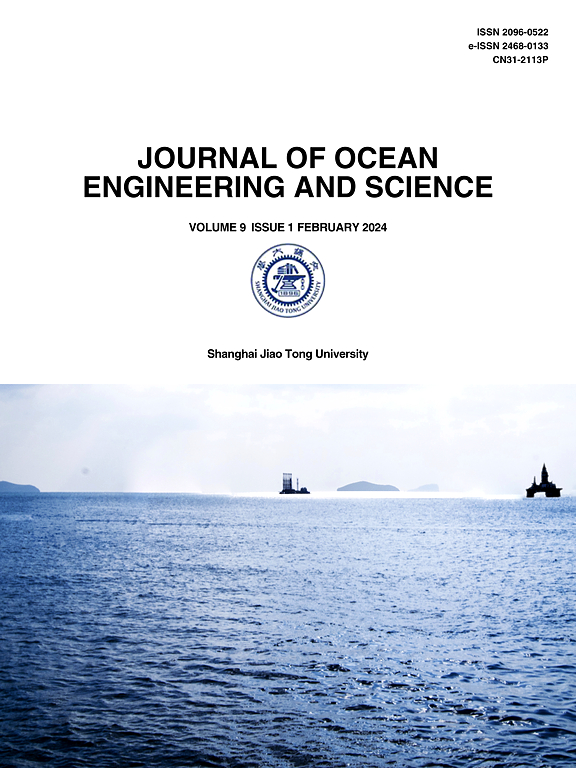沉船离底仿真的一种新型多模块耦合算法
IF 11.8
1区 工程技术
Q1 ENGINEERING, MARINE
引用次数: 0
摘要
本文提出了一种新的沉船离底仿真多模块耦合算法,该算法涉及多种结构、多种介质和三个模块:沉船-土壤相互作用模块、提升-缓冲模块和驳船-缆索耦合模块。该算法将有限元法、势流法和集总质量法相结合,用于模拟离底过程。研究了典型打捞箱在额定升降张力下的动态响应特性。研究发现,在波浪作用下,打捞系统表现出一种特殊的突围现象,沉船位移急剧增大,吊张力分布不均匀。个案研究,以进一步确定爆发的机制。随着额定起升张力的增大,打捞效率提高,而沉船最大横摇幅值和俯仰幅值减小。同时,较大的额定张力可能会造成设备提升能力的浪费,因此最终选择229吨作为合适的预置提升张力。此外,当波浪方向角从90°增加到180°时,沉船的最大横摇值大致呈减小趋势,打捞驳船相对于沉船的平面偏转减小。而俯仰、偏航、提升张力和Mises海床土应力的最大值呈不规则波动。考虑到所有的动态指标,150到180度的波浪朝向间隔预计是一个理想的操作窗口。相反,105°的情况是危险的。本文章由计算机程序翻译,如有差异,请以英文原文为准。
A novel multi-module coupled algorithm for the wreck off-bottom simulation
This paper proposes a novel multi-module coupled algorithm for the wreck off-bottom simulation (MCAWOS), involving several structures, multiple mediums, and three modules: the wreck-soil interaction module, the lifting-buffering module, and the barge-cable coupled module. In the present algorithm, the finite element method, the potential flow method and the lumped mass method are integrated and used to simulate the off-bottom process. The dynamic response characteristics of a typical salvage case with rated lifting tensions are investigated. It is found that the salvage system in waves exhibits a special breakout phenomenon, where the wreck displacements increase abruptly, and uneven distributions of the lifting tensions are observed. Case studies are conducted to further ascertain the mechanism of the breakout. As the rated lifting tension increases, the salvage efficiency rises, while the maximum roll and pitch amplitudes of the wreck decrease. Meanwhile, larger rated tension may result in more waste in equipment lifting capacity, thus 229 ton is finally selected as the appropriate preset lifting tension. In addition, when the wave direction angle increases from 90 to 180, the maximum roll value of the wreck shows a roughly decreasing trend and the planar deflection of the salvage barge relative to the wreck decreases. However, the maximum values of pitch, yaw, lifting tension and Mises seabed soil stress show irregular fluctuations. Taking all dynamic indicators into account, the wave heading interval of 150 to 180 is expected to be an ideal operating window. Conversely the 105 case is a dangerous state.
求助全文
通过发布文献求助,成功后即可免费获取论文全文。
去求助
来源期刊

Journal of Ocean Engineering and Science
Multiple-
CiteScore
11.50
自引率
19.70%
发文量
224
审稿时长
29 days
期刊介绍:
The Journal of Ocean Engineering and Science (JOES) serves as a platform for disseminating original research and advancements in the realm of ocean engineering and science.
JOES encourages the submission of papers covering various aspects of ocean engineering and science.
 求助内容:
求助内容: 应助结果提醒方式:
应助结果提醒方式:


